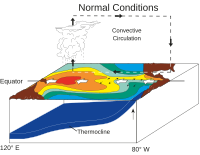
Photo from wikipedia
In this paper we investigate the evolution of moderate El Niño events during their developing phase with the objective to understand why some of them did not evolve as extreme… Click to show full abstract
In this paper we investigate the evolution of moderate El Niño events during their developing phase with the objective to understand why some of them did not evolve as extreme events despite favourable conditions for the non-linear amplification of the Bjerknes feedback (i.e. warm SST in Austral winter in the eastern equatorial Pacific). Among the moderate events, two classes are considered consisting in the Eastern Pacific (EP) El Niño events and Central Pacific (CP) events. We first show that the observed SST variability across moderate El Niño events (i.e. inter-event variability) is largest in the far eastern Pacific (east of ~ 130°W) in the Austral winter prior to their peak, which is associated to either significant warm anomaly (moderate EP El Niño) or an anomaly between weak warm and cold (moderate CP El Niño) as reveals by the EOF analysis of the SST anomaly evolution during the development phase of El Niño across the El Niño years. Singular value decomposition (SVD) analysis of SST and wind stress anomalies across the El Niño years further indicates that the inter-event SST variability is associated with an air–sea mode explaining 31% of the covariance between SST and wind stress. The associated SST pattern consists in SST anomalies developing along the coast of Ecuador in Austral fall and expanding westward as far as 130°W in Austral winter. The associated wind stress pattern features westerlies (easterlies) west of ~ 130°W along the equator peaking around June–August for EP (CP) El Niño events. This air–sea mode is interpreted as resulting from a developing seasonal Bjerknes feedback for EP El Niño events since it is shown to be associated to a Kelvin wave response at its peak phase. However equatorial easterlies east of 130°W emerge in September that counters the growing SST anomalies associated to the air–sea mode. These have been particularly active during both the 1972 and the 2015 El Niño events. It is shown that the easterlies are connected to an off-equatorial southerly wind off the coast of Peru and Ecuador. The southerly wind is a response to the coastal SST anomalies off Peru developing from Austral fall. Implications of our results for the understanding of the seasonal ENSO dynamics and diversity are discussed in the light of the analysis of two global climate models simulating realistically ENSO diversity (GFDL_CM2.1 and CESM).
Journal Title: Climate Dynamics
Year Published: 2017
Link to full text (if available)
Share on Social Media: Sign Up to like & get
recommendations!